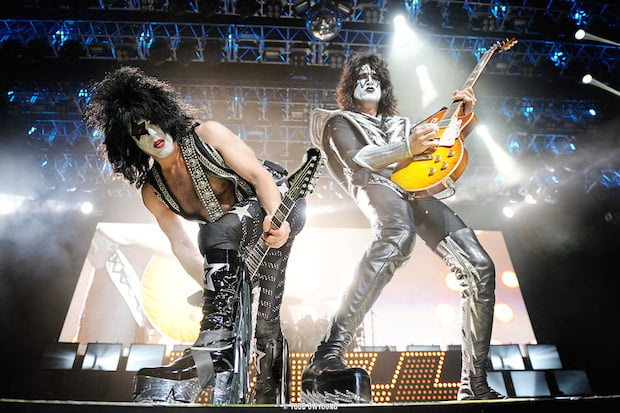Camera Settings for Concert Photography

Choosing the right camera settings for concert photography can be a daunting task, even for experienced music photographers. Here’s a breakdown of every major camera setting that I recommend for shooting live music.
Exposure Mode
Manual exposure is going to be your best bet for concert photography. Due to the large dynamic range of a concert, in which there can be very bright lights and deep shadows, any camera-metered mode can be easily fooled and produce poor exposures. As a result, manual mode is a much more consistent way of exposing images over auto modes like aperture priority or shutter priority.
Recommended setting: Manual Exposure
Aperture
This one is easy. Shoot wide open at the largest aperture you can with your lens. This will be the f-stop with the smallest value, which means that the most light will get to the sensor. Even the most brightly lit concerts are dim compared to daylight, so a wide aperture is needed to gather as much light as possible.
With zooms, the only time I stop down in live music photography is if I am already shooting around 1/500 or higher. When shooting with prime lenses with a fast f/1.4 or f/1.8 aperture, I still shoot wide open, since lighting is often poor if I need the speed of those lenses in the first place.
My advice for live music photography: Shoot wide open, or with the maximum aperture of your lens.
Recommended Setting: Shoot wide open!
Shutter Speed
When at all possible, I like to shoot at 1/250 or faster, but this is often only a luxury for larger, well-lit shows. For smaller club shows when lighting may be mediocre, I am try and stay in a range between 1/100-1/200 as a minimum for my shutter speed. This range is fast enough to freeze a fair degree of motion and eliminate most major camera shake, all without needing a ton of light. Below 1/100, there’s greater chance for blur in images, particularly with faster moving bands.
Recommended Setting: 1/100-1/200, faster whenever possible
ISO
ISO levels up to 3200 will produce very good quality for almost all DSLR cameras. For compact P&S cameras, 1600 and lower will produce the best results.
All this said, when light is finite (which is almost always for indoor concert photography), I would never hesitate to crank up the ISO to whatever produces the best exposure. This is especially true when either ISO or shutter speed must change to achieve a proper exposure. I’ll always take more digital noise/grain over a blurry image. Crank the ISO.
Recommended Setting: Whatever gets the job done!
AF Setting
I shoot with AF-C (continuous) on my Nikons, which is the same as the AI Servo mode on Canon DSLRs. This continuous focusing lets me track motion until the moment I press the shutter release. For dynamic subjects of live music, AF-C is a huge benefit.
Recommended Setting: AF-C (Nikon)/AI Servo AF (Canon)
White Balance
Auto. I shoot Auto WB about 99% of the time. While shooting with a preset white balance will offer better image quality if you know the exact values to use, the opportunity and ability to precisely set a Kelvin value during live music is limited at best. Setting WB in post makes for much faster shooting — high speed, low drag.
Recommended Setting: Auto WB
Drive Mode
I recommend shooting in continuous mode at the highest frame rate possible. For those high key moments when you want a high frame rate, you’re set — and when you don’t need the speed, a light shutter finger allows single frames with ease. As a concert photographer, high continuous shooting is the way to go.
Recommended Setting: Continuous (high)
RAW OR JPG
Shoot in RAW. Memory cards and harddrives are cheap. Unless you don’t care about what you’re shooting (which only begs the question, why are you pressing the button in the first place?), there is no reason to pass over RAW for JPG. If you must, for speed of processing and/or delivery, shoot in RAW + JPG mode so that you at least have the RAW files for future use.
Recommended Setting: RAW
Sample Concert Photography Images and Exposure Info
Talk is cheap, so I thought it would be helpful to give some example live music photography with camera, lens and camera settings. These images come from my portfolio and I think that they’re a good representation of the above advice for the real world exposure settings I use.












Hopefully these twelve images will give you a good idea of the settings I use as a concert photographer.
To recap my recommended camera settings for concert photography:
- Exposure Mode: Manual
- Aperture: Wide Open
- Shutter Speed: 1/100-1/200 or faster
- ISO: 1600-3200 (or whatever gets the job done)
- AF Setting: AF-C/AI Servo AF
- White Balance: Auto WB
- Drive Mode: Continuous High
- File Format: RAW
About the author: Todd Owyoung is an internationally published photographer specializing in live music, lifestyle and portrait photography. Based out of New York City, Owyoung has been published in Rolling Stone, The New York Times, Q Magazine, SPIN, Billboard, Entertainment Weekly, Alternative Press, and more. You can find out more about his on his website, or by following him on Twitter, Facebook, Instagram or Google+. This article originally appeared here.